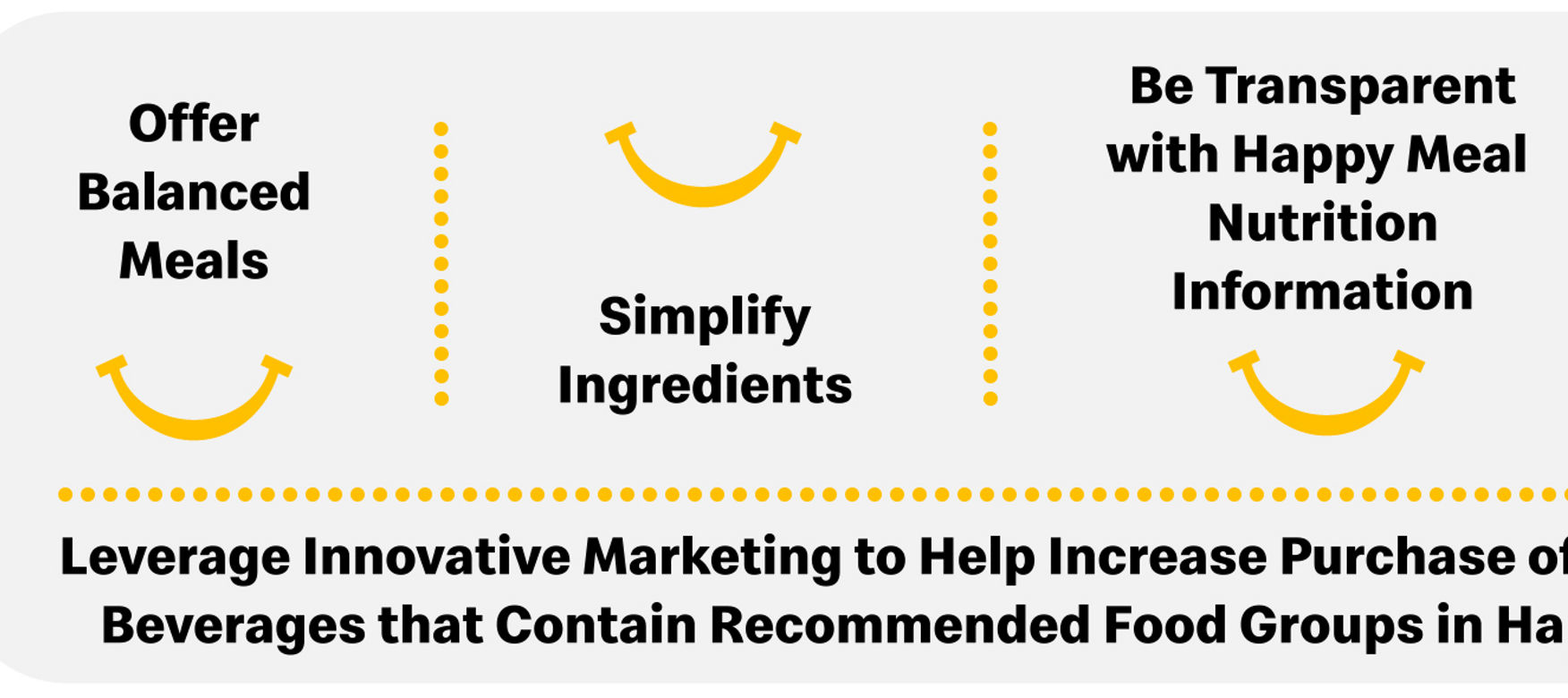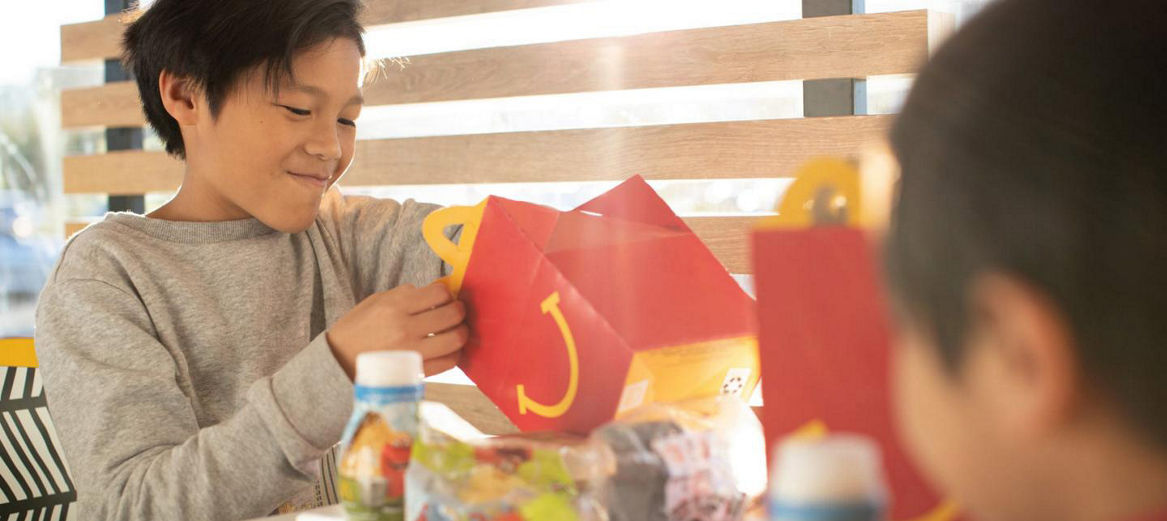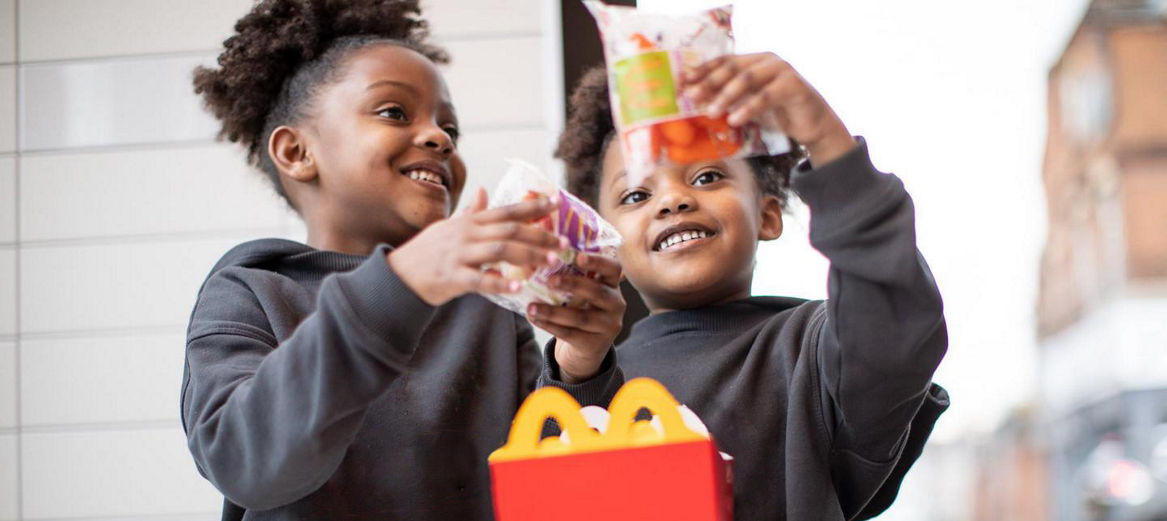Nutrition & Marketing Practices
As one of the most frequented restaurants in the world, we help feed millions of people every day, with a focus on offering families the choices they love.
We are always listening to our customers and evaluating our menu to identify ways to evolve our offerings while maintaining the great taste people know and love. We provide a variety of choices and bring families together to share moments and create lasting memories.
Parents in particular are looking for menu choices that they can feel good about when it comes to feeding their kids, and that’s why we’re focused on evolving the Happy Meal and making balanced meals more accessible to families across the world. McDonald’s will continue to take a responsible approach to our Happy Meals by offering balanced options and promoting menu items that contribute to recommended food groups, such as fruits, vegetables and low-fat dairy.
Recent Progress
Continued supporting markets on their progress against the Global Happy Meal Goals, which we are on track to publish progress against in 2023.
Integrated our nutrition strategy into the Sustainability and ESG team to provide leadership, coordination and support for McDonald’s global nutrition goals, policies and reporting.
Strengthened internal network with representation from Nutrition, Sustainability, Quality Assurance and Supply Chain functions to collaborate and share best practices on nutrition across the Company and insights across our global markets.
To learn more about our progress on Happy Meals, download our Global Happy Meal Goals 2020 Interim Progress Report (PDF – 28.2 MB), or read the Our Performance section below.
We aim to achieve these goals in all markets globally1 by the end of 2022. The measurement and progress reporting covers 20 major markets,2 representing nearly 85% of the McDonald’s System’s global Happy Meal sales. Due to McDonald’s Corporation’s announcement to exit the Russian market in May 2022, the inclusion and reporting of Russia in our final Global Happy Meal Goals Progress Report may vary. Keybridge, an independent third party, supports us in defining our targets, measuring and publicly reporting our progress in these markets.
Marketing Responsibly
We’re proud of our long history as an industry leader in responsible marketing to children. To address responsible marketing to children at both a Company and an industry level, we participate in a number of local and regional pledges such as the EU Pledge and the U.S. Children’s Food & Beverage Advertising Initiative.
McDonald’s Global Marketing to Children Guidelines incorporate many of McDonald’s commitments related to responsible marketing in this area, and apply to all of our markets around the world. In each of our markets, family marketing employees are required to take an e-learning course on these Guidelines. We recognize the role we play as the leading global foodservice retailer and are actively involved in self-regulation focused on this important issue.
Supporting Informed Decisions
McDonald’s recognizes the importance of nutrition labeling and aims to help consumers make informed choices. From printed brochures and nutrition labeling on select food packaging to innovative use of our mobile apps, kiosks and online nutrition calculators, as well as displaying calories on menu boards, many of our markets publish nutrition information in a variety of ways to our customers.
Our Performance
The Global Happy Meal Goals apply to all markets globally,1 with measurement and reporting of progress ongoing among our 20 major markets.2
Our Global Happy Meal Goals 2020 Interim Progress Report captures our latest progress toward the five Global Happy Meal Goals, leveraging the latest data available for each goal. Our third-party validator Keybridge audited our measurement and reporting.
We plan to publish our final progress report in 2023, which will include our performance against the goals as of the end of 2022. We are working closely with markets to achieve our goals by the target date, and to identify any market-specific situations that may warrant a limited extension or exemption, such as local regulatory standards or unique operational circumstances. Despite challenges faced during the pandemic, we remain focused on actions we can take to help promote more balanced choices for kids, including leveraging innovative marketing practices to promote recommended food groups in Happy Meals.
Offer Balanced Meals Goal
By the end of 2022, ensure 50% or more of the Happy Meal Bundle Offerings listed on menus in each market meet McDonald’s Global Happy Meal Nutrition Criteria of less than or equal to: 600 calories, 10% of calories from saturated fat, 650 mg of sodium and 10% of calories from added sugar.
Progress
8 of the 20 major markets met the goal in 2019, up from 3 markets in 2018.
An average of 43% of Happy Meal Bundles met the Nutrition Criteria across the 20 major markets in 2019.
Simplify Ingredients Goal
By the end of 2022, remove artificial flavors and added colors from artificial sources in Happy Meals, and reduce artificial preservatives where feasible in Happy Meals without sacrificing the safety, taste, quality or value of our food.
Progress
12 of the 20 major markets met the goal in early 2020.
Be Transparent With Happy Meal Nutrition Information Goal
By the end of 2022, ensure that nutrition information for Happy Meals is available and accessible through all owned websites and mobile apps used for ordering where they exist.
Progress
12 of the 20 major markets met the goal in Q2 2020, up from 6 markets in Q1 2019.
Market Responsibly Goal
By the end of 2022, all Happy Meal Bundles advertised to children will meet McDonald’s Global Happy Meal Nutrition Criteria and continue to meet any existing applicable local/regional advertising pledges.
Progress
16 of the 20 major markets met the goal in 2019.
Additionally, 100% of ads shown to children in 2019 featured water, milk or juice as the Happy Meal beverage, and fruits, vegetables or dairy as the Happy Meal side.
Leverage Innovative Marketing Goal
By the end of 2022, leverage innovative marketing to help increase purchase of foods and beverages that contain recommended food groups in Happy Meals.
Progress
16 of the 20 major markets sold an increased share of Happy Meal items containing recommended food groups in 2019 as compared to 2018.
Our Actions
Market Focus: Nutrition Improvements in the U.K.
McDonald’s U.K. wants to make it easier for our customers to make balanced choices. Our nutrition strategy in the U.K. has been in place for over 15 years. During this time, we have reformulated over 200 of our ingredients and invested heavily in broadening our menu of balanced healthy options. We have introduced more salad options, as well as fruit and vegetable bags, orange juice, mineral water and organic semi-skimmed milk. Currently, 92% of our core food and drink menu is under 500 calories.
We review and update our Happy Meal menu regularly. Around 70% of items in our Happy Meal menu are non-high in fat, salt and sugar (non-HFSS), according to the U.K. Government’s Nutrient Profiling Model.
As part of our broader efforts, we are leveraging technology to encourage customers to choose balanced options. Showing the lower-calorie soft drinks first on our menu ordering screens has encouraged more customers to buy them – with over 1.9 million purchases switched from higher sugar variants to the no-added-sugar options3 when this was first introduced in 2017.
Market Focus: Evolving the Menu in the U.S.
McDonald’s USA is always looking for ways to innovate and evolve our menu options. Starting in 2018, the beef served in Quarter Pounder®4 burgers in the U.S. is sourced only from North America,5,6 and cooked fresh in restaurants across the country. In 2018, we announced that all of our classic burgers have no artificial preservatives, artificial flavors or added colors from artificial sources. Currently, our pickle does contain an artificial preservative.5
In early 2020, we introduced a new reduced-sugar, low-fat chocolate milk that contains 25% less sugar than leading quick service restaurants’ low-fat chocolate milk.7 It’s a great example of how we partner with the dairy industry and our supply chain to create a menu innovation and offer more balanced options for our younger guests.
Market Focus: Helping Customers Choose the Healthier Option in the Netherlands
McDonald’s Netherlands’s ongoing commitment to support customers in choosing a more varied diet, alongside product improvements, is what helps us advance our menu further to keep delivering healthier options. Aiming to continually improve their menu offering, McDonald’s Netherlands have offered water as the default drink for their Happy Meals for several years. In 2019, a further menu update was made so that Cheeseburgers are now available by request only. More recently, further menu updates have resulted in McDonald’s Netherlands achieving 12 million pieces of fruit sold every year. For example, the dessert menu now contains more fruit and vegetable options.
Footnotes
1 It is important to note that our global System consists of both Company-owned and franchised restaurants. The franchised restaurants are operated by conventional Franchisees, Developmental Licensees (i.e., a Franchisee that operates most or all of the McDonald’s-branded restaurants in a specific market) or pursuant to other licensing arrangements, and make up the majority of McDonald’s-branded restaurants around the world. Our Franchisees make independent decisions for their own business organizations, subject to their obligations under the operative franchise or other license agreements and core standards required for the McDonald’s brand. McDonald’s does not prescribe all business requirements for our Franchisees, but rather we work in collaboration with them to raise awareness and provide tools and opportunities to assist them as part of the brand’s food journey. We also work with Franchisees to mutually set objectives and targets and to help monitor their related progress. As a result, while we will encourage Franchisees to participate in the important goals outlined in this document, we cannot guarantee their compliance. However, we can drive change in our Company-owned restaurants, so much of this work will start with Company-owned restaurants, with a plan to demonstrate success and expand measurement, and that will ultimately help to support independent Franchisees that choose to join us on this journey.
2 Our major markets include the U.S., Canada, Brazil, Argentina, the U.K., France, Germany, Austria, Spain, Netherlands, Italy, Poland, Sweden, Switzerland, Russia, Hong Kong, China, Japan, Taiwan and Australia. Due to McDonald’s Corporation’s announcement to exit the Russian market in May 2022, the inclusion and reporting of Russia in our final Global Happy Meal Goals Progress Report may vary.
3 Purchases of Coca-Cola Classic switched to Coke Zero or Diet Coke.
5 Available at most restaurants in the contiguous U.S. Not available in Alaska, Hawaii and the U.S. territories.
6 National sandwiches only. Excludes local and limited time options.
7 14 g of sugar vs. avg. 22 g at leading quick service restaurants.






